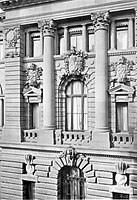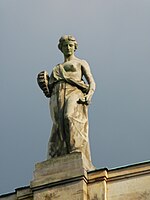Theodor Bausch
Theodor Bausch (born December 19, 1849 in Stuttgart ; † March 3, 1925 there ) was a German sculptor and since 1897 a professor at the Stuttgart Art Academy .
Life
Theodor Bausch was born on December 19, 1849, the son of the carpenter and piano maker Wilhelm Friedrich Bausch († around 1893) in Stuttgart. He completed an apprenticeship as a wood sculptor and then studied at the Stuttgart Art Academy under the professor of plastic Theodor Wagner . From 1875 to 1881 he studied at the Dresden Art Academy as a master student and assistant to Johannes Schilling , among other things he was involved in the execution of the Niederwald monument .
In 1883 he settled in Stuttgart again, where he lived in his parents' house (Rothestraße 4, today Theodor-Heuss-Straße ). In 1888 he went on a long study trip to Italy and France. He then moved into an apartment in Eugenstrasse 9 and a studio in Neckarstrasse 7, both in the vicinity of the Art Academy and the Museum of Fine Arts, today's Alte Staatsgalerie .
In 1897 Bausch was appointed professor at the Stuttgart Art Academy (official name from 1901 Royal Württemberg Academy of Fine Arts ). Bausch died in Stuttgart on March 3, 1925, at the age of 75.
Works
| → Column sorting |
| image | year | place | Location | object |
|---|---|---|---|---|
|
|
1879 | Stuttgart | Prague cemetery | Tomb of the chocolate manufacturer Eduard Otto Moser in the Prague cemetery in Department 4, 1879 or later. Classicist grave complex based on a design by the architect Robert von Reinhardt , the angel statue and the bronze door were created by Theodor Bausch. |
|
|
1887 | Stuttgart | Prague cemetery | Tomb of the sculptor Ludwig von Hofer in the Prague cemetery in section 8. Stele with a marble bust, 1887 or later. |
|
|
1888 | To sing | Hohentwiel Fortress | Armory gate of fortress Hohentwiel with 2 relief medallions made of bronze: relief by Otto von Bismarck and relief by Joseph Victor von Scheffel . As it was in 1907, today the reliefs are on two remains of the wall inside the former armory. Detail photos: Bismarck relief , Scheffel relief . |
|
|
1888 | Stuttgart | Municipal Lapidarium Stuttgart | Nymph fountain at the Neckartor in Stuttgart with the figure of a spring nymph or well nymph, → illustration . Model: Johann Heinrich Dannecker 1817, sandstone finish: Theodor Wagner 1843, replacement with more durable marble finish: Theodor Bausch 1888. In 1944 the fountain was destroyed, the figure of the nymph was placed in the Stuttgart lapidarium (number 50). - A fountain with a copy of the nymph is in the Lower Palace Gardens in Stuttgart, → photo . |
|
|
1893 | Wiesbaden | Hessian State Theater | 4 niche figures on the south facade of the Hessian State Theater: allegories of drama, song, music and dance. See: Hessisches Staatstheater Wiesbaden # Theater . |
|
|
1895 | Darmstadt | Technical University , old main building | Gable field group on the old main building of the Technical University Darmstadmit with Athena and allegorical figures of engineering, geometry, architecture and mechanics. |
|
|
1896 | Stuttgart | Willi-Bleicher-Strasse 19 | 2 attic statues at the Landesgewerbemuseum Stuttgart (today Haus der Wirtschaft ): allegories of agriculture and mining, destroyed. |
|
|
1896 | Stuttgart | Willi-Bleicher-Strasse 19 | Heraldic shields at the Landesgewerbemuseum Stuttgart (today the House of Business ). Illustration (as an example): 3 coats of arms of an unknown author. |
| 1897 | Stuttgart | Augustenstrasse 1 | Rubinstein memorial plaque on Augustenstrasse 1, destroyed. In memory of the composer, pianist and conductor Anton Grigorjewitsch Rubinstein , who lived at Augustenstraße 1 in 1856. | |
|
|
1898 | Ulm | Ulm District Court | 6 allegorical attic statues by Adolf von Donndorf and Theodor Bausch on the central building of the Ulm Regional Court. The figures symbolize fear of God, steadfastness, peacefulness, truthfulness, wisdom and prudence. |
|
|
1901 | Stuttgart | Johann-Sebastian-Bach-Platz | Goose step fountain with the bronze figure of a goose shepherd with two water-spouting geese and two water-spouting bronze masks on the shaft of the fountain. |
|
|
1902 | Esslingen am Neckar | Ebershaldenfriedhof , funeral hall | Funeral hall on the Ebershaldenfriedhof in Esslingen am Neckar with an angel figure as the crowning of the dome and a bronze portal with 2 flanking relief panels: "Mother with child" and "Old man who faces death". |
|
|
1908 | Stuttgart | Marketplace 14 | Hans Sachs statue on the corner of the Bletzinger shoe store at Marktplatz 14 in Stuttgart. Design: Theodor Bausch. Execution: Richard Schönfeld. |
|
|
1912 | Stuttgart | State Theater Stuttgart , Large House | One of ten 4 meter high figures of the portico coronation of the Great House of the State Theater Stuttgart, 3rd figure from left: Allegory of technology. Draft based on movement sketches by Ludwig Habich , Allegories of the arts that come into play in the creation of scenic processes. Execution: Richard and Willy Schönfeld. |
|
|
1912 | Stuttgart | Marble bust of the zoologist Prof. Gustav Jäger ("wool hunter" or "soul hunter"). Most recently in the Städtisches Lapidarium Stuttgart (number 149), whereabouts unknown. |
literature
- Germany, Austria-Hungary and Switzerland scholars, artists and writers in words and pictures. Volume 1. Volger, Leipzig 1908, pages 30-31. ( online as pdf )
- Bausch, Theodor . In: Ulrich Thieme , Felix Becker (Hrsg.): General Lexicon of Fine Artists from Antiquity to the Present . Founded by Ulrich Thieme and Felix Becker. tape 3 : Bassano – Bickham . Wilhelm Engelmann, Leipzig 1909, p. 93 ( Textarchiv - Internet Archive ).
- Gustav Wais : Stuttgart's art and cultural monuments. 25 pictures with city history, architectural history and art history explanations. Stuttgart 1954.
- Bausch, Theodor . In: Hans Vollmer (Hrsg.): General Lexicon of Fine Artists of the XX. Century. tape 5 : V-Z. Supplements: A-G . EA Seemann, Leipzig 1961, p. 279 .
- Monika Spiller: Bausch, Theodor . In: General Artist Lexicon . The visual artists of all times and peoples (AKL). Volume 7, Saur, Munich a. a. 1993, ISBN 3-598-22747-7 , p. 637.
Web links
Footnotes
- ^ Stuttgart address books 1871–1900.
- ↑ Bausch's home and studio in Stuttgart have not been preserved.
- ↑ #Spiller 1993 .
- ↑ Alternative year of death: 1928 ( #Spiller 1993 , #Vollmer 1961 ).
- ↑ #Wais 1954.1 , page 80.
- ↑ #Wais 1954.1 , page 79.
- ^ Ulm Regional Court, courthouse .
- ^ Keppler: The new morgue in Eßlingen. In: Württembergische Bauzeitung, 1904, page 371, pdf .
- ^ #Wais 1954.1 , page 24.
- ^ #Wais 1954.1 , page 119.
| personal data | |
|---|---|
| SURNAME | Bausch, Theodor |
| BRIEF DESCRIPTION | German sculptor and university professor |
| DATE OF BIRTH | December 19, 1849 |
| PLACE OF BIRTH | Stuttgart |
| DATE OF DEATH | March 3, 1925 |
| Place of death | Stuttgart |












